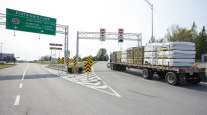Pilot Program Aims to Expedite Truck Traffic at Canada’s 2nd-Busiest Port of Entry
Canadian officials hope to expedite truck traffic at one of its busiest ports of entry from the United States by removing some credentialing requirements that Canada’s trucking industry said are redundant.
A pilot program at the Blue Water Bridge in Sarnia, Ontario, has opened the Free and Secure Trade lanes to carriers and shippers that participate in either the Customs Self-Assessment or Partners in Protection programs, the Canadian Border Services Agency said. Usually, carriers and shippers must participate in both programs to use FAST.
“With $1.9 billion worth of goods and services crossing our shared border every day, we have a vested interest in reducing barriers to trade,” Patricia Davidson, member of Parliament, said in a statement Friday on behalf of Vic Toews, Canada’s minister of public safety.
“The pilot aims to further reduce border wait times for trusted traders, thereby strengthening the security and economy of both nations,” the statement said.
Davidson launched the pilot in an event at the Blue Water Bridge, along with officials from CBSA and the Canadian Trucking Alliance. The government reported that 1.56 million trucks crossed into Canada at the bridge in 2011, making it the second-busiest port of entry for trucks behind the Ambassador Bridge, which connects Detroit to Windsor, Ontario.
By requiring only one trusted trader certification for the carrier and one for the shipper or importer, the six-month pilot more closely matches requirements of crossing into the United States, said David Bradley, CTA’s chief executive officer.




